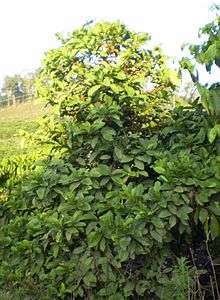Coffea liberica
Coffea liberica (or Liberian coffee) is a species of flowering plant in the family Rubiaceae from which coffee is produced. It is native to western and central Africa from Liberia to Uganda and Angola, and has become naturalized in the Philippines, Indonesia, Seychelles, the Andaman & Nicobar Islands, Malaysia [2][3]
| Coffea liberica | |
|---|---|
 | |
| Scientific classification | |
| Kingdom: | Plantae |
| Clade: | Tracheophytes |
| Clade: | Angiosperms |
| Clade: | Eudicots |
| Clade: | Asterids |
| Order: | Gentianales |
| Family: | Rubiaceae |
| Genus: | Coffea |
| Species: | C. liberica |
| Binomial name | |
| Coffea liberica | |
| Synonyms[1] | |
| |
Cultivation and use
The Coffea liberica tree grows up to 9 metres in height, producing larger fruits than those found on Coffea arabica trees. It was brought to Indonesia to replace the arabica trees killed by the coffee rust disease at the end of the 19th century. It is still found in parts of Central and East Java and West Kalimantan today. A rare and one of a kind cultivar of Liberica can be found in a secluded area of the Amazon Rainforest of Guyana.
Liberica is also the main coffee species cultivated in the Philippines and Malaysia. The city of Lipa in those province of Batangas became the country's biggest producer of arabica in the 1880s until that industry collapsed from coffee rust in the 1890s, killing almost all arabica plants in the area and threatening the variety with extinction. As in Indonesia, the liberica bean was brought in to replace it. Today, Batangas and the neighboring province of Cavite are producers of a varietal of liberica known as barako (Spanish: café verraco). In Malaysia it is generally grown in Malaysia's Coffee Belt on the West Coast of Johor largely due to Javanese immigration to Malaysia in the 19th century.
Liberica coffee beans are much larger than the more popular Arabica and Robusta beans.[4] Due to its rareness and limited supply on a global level, the cost of regular Liberica beans are on the higher end with premium Liberica beans carrying a heavier price tag. The caffeine concentration of Liberica beans is the lowest of the three cultivars, with 1.23 g/100 g, where Arabica has 1.61 g/100 g and Robusta has 1.26 g/100 g. [5]
Taxonomy
Coffea dewevrei, Coffea dybowskii and Coffea excelsa were formerly considered as separate species but were reclassified in 2006 as synonyms for Coffea liberica var. dewevrei.[1]
References
- Davis, AP; Govaert R; Bridson DM; Stoffelen P (December 2006). "An annotated taxonomic conspectus of the genus Coffea (Rubiaceae)". Botanical Journal of the Linnean Society. 152 (4): 465–512. doi:10.1111/j.1095-8339.2006.00584.x.
- "World Checklist of Selected Plant Families: Royal Botanic Gardens, Kew". apps.kew.org. Retrieved 2017-07-18.
- "Coffees of Malaysia". espressocoffeeguide.com. Retrieved 2018-04-16.
- Culture, Coffee. https://club.atlascoffeeclub.com/4-main-types-of-coffee-beans/. Missing or empty
|title=(help) - https://www.ukm.my/mjas/v7_n2/7Liew.pdf
External links
| Wikimedia Commons has media related to Coffea liberica. |
- World Checklist of Rubiaceae
- Coffea liberica, United Nations' Food and Agriculture Organization website
| Wikispecies has information related to Coffea liberica |
